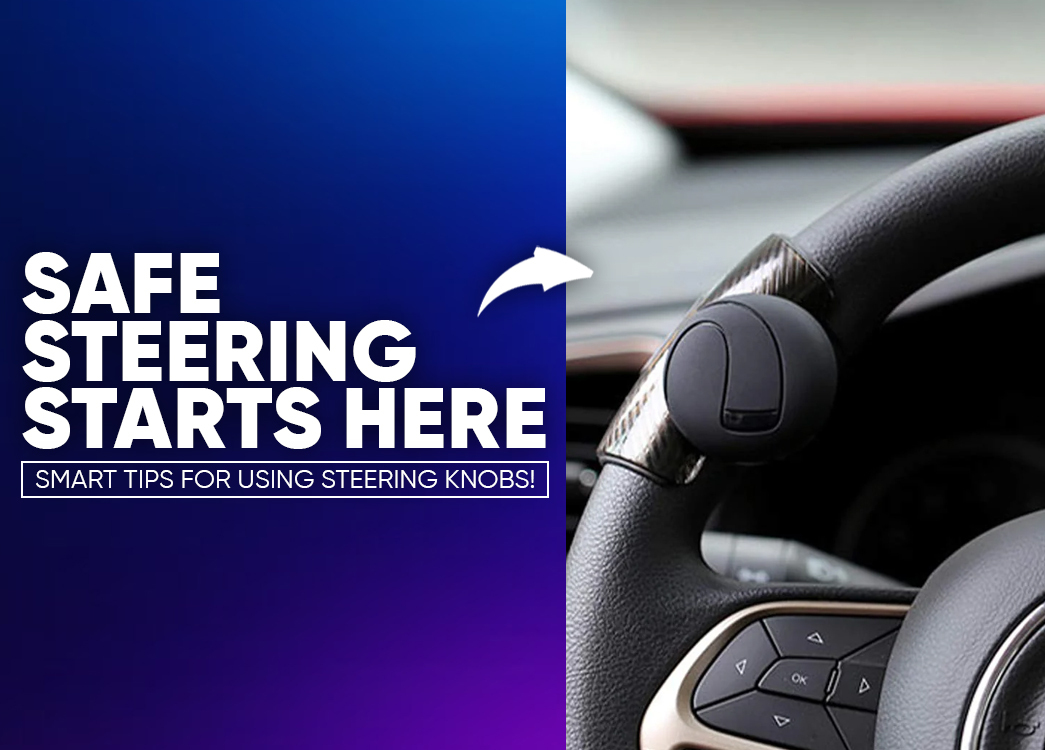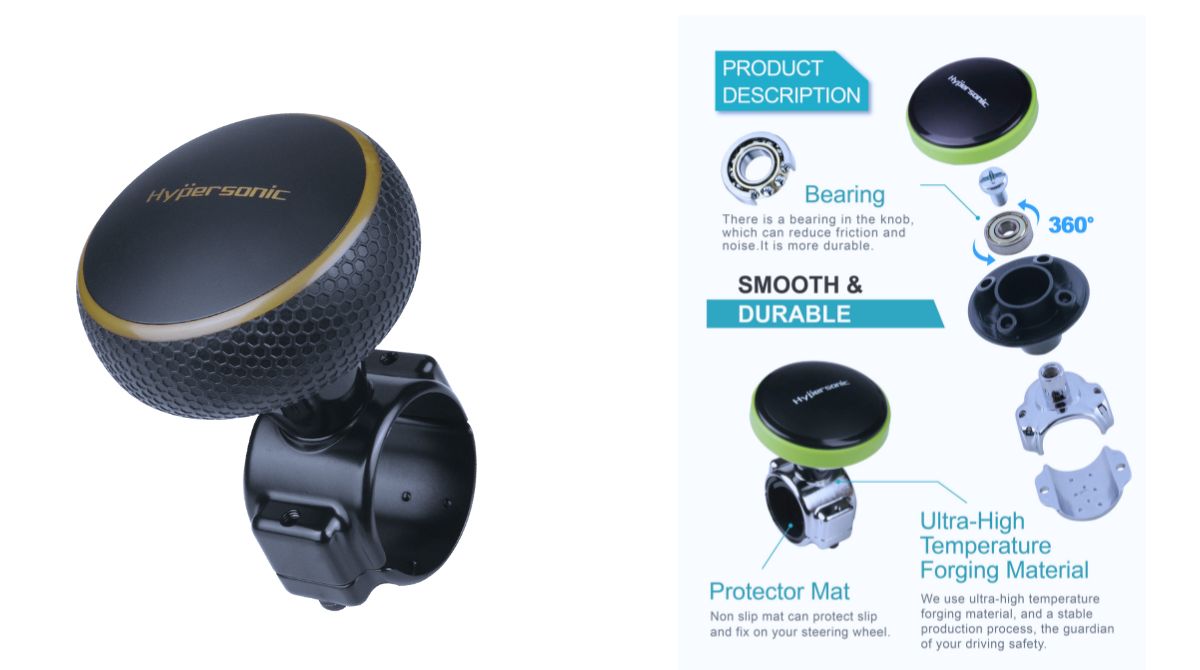
By creckk On 31-10-2025 at 9:33 am
Steering Knob Safety Guide: How to Use Steering Wheel Knobs the Right Way for Safer, Easier Driving
Introduction: Why Drivers Are Talking About Steering Knobs
Ever struggled with tight parking spots or felt your shoulders ache after long hours of driving? A simple tool called a steering wheel knob might be the comfort upgrade you didn’t know you needed. Also known as a steering spinner, Brodie knob, or spinner handle, this small add-on gives drivers smoother one-handed control while parking, turning, or navigating narrow streets. Originally used in tractors and industrial vehicles, steering knobs are now popular in everyday cars for their convenience and control.
Whether you’re looking to reduce fatigue, manage physical limitations, or simply make your daily drive smoother, understanding how these knobs work and using them safely can completely transform your driving experience.
What Is a Steering Wheel Knob?

A steering wheel knob is a compact, ball-like handle that attaches to your car’s steering wheel. It allows you to rotate the wheel quickly and efficiently using one hand. Initially designed for heavy-duty vehicles like tractors and forklifts, steering knobs have become a go-to tool for commercial drivers, delivery operators, and everyday motorists who deal with tight maneuvers.
Commonly used by drivers with limited arm strength or mobility, these knobs provide extra leverage and control—especially useful in city driving or when parking in cramped spaces.
Structure, Design, and Quality Indicators for Steering Knobs
A good steering knob might look simple, but its safety and performance depend on solid design and materials. Here’s a quick breakdown:
| Component | Function | Quality Indicators |
|---|---|---|
| Clamp | Attaches the knob to the wheel | Strong metal or polymer build, rubber liner for grip, tight locking mechanism |
| Knob | Main handle used for rotation | Ergonomic design, comfortable shape, non-slip surface (rubber, metal, or wood) |
| Bearing | Allows smooth spinning of the knob | Durable mechanism, smooth rotation, no wobbling or sticking |
Top-quality knobs feature protective linings to prevent scratches, precision bearings for friction-free spinning, and sturdy clamps that won’t loosen over time. Many also come in premium finishes like woodgrain, carbon fiber, or matte metal to match your car’s interior.
Key Benefits of Using a Steering Knob
Though small, a steering knob brings major advantages for daily and commercial drivers alike:
- Easier Maneuvering: Perfect for tight parking or three-point turns, it allows faster and more efficient wheel rotation with less hand movement.
- Reduced Arm Fatigue: Ideal for long-distance or city drivers who make frequent turns. It decreases shoulder and wrist strain during repetitive driving motions.
- Accessibility: Offers better control for drivers with limited arm mobility or strength, enabling independent, confident driving.
- Precision Control: Helps with fine maneuvers in larger vehicles like trucks, RVs, or buses where tighter turns are needed.
- Enhanced Efficiency: Saves time for delivery drivers and ride-hailing professionals by making repeated steering motions quicker and smoother.
Why Steering Knobs Can Be Safe When Used Correctly?

Steering knobs are safe if you follow proper installation, usage, and maintenance. Here are the best practices every driver should know:
| Key Point | Reason |
|---|---|
| Proper Installation | Ensure the clamp is tightly secured to prevent slippage or detachment. Follow the manufacturer’s instructions for positioning and fastening. |
| Enhanced Control at Low Speeds | Perfect for one-handed turns during parking or tight maneuvers where precision is key. |
| Responsibility & Best Practices | Use one-handed control for low-speed turns but switch to two hands for highway driving or emergencies. |
| Regular Maintenance Checks | Inspect for wear, rust, or loose screws regularly to prevent accidents or detachment. |
| Accessibility Benefits | Improves driving safety for those with limited mobility while reducing fatigue and providing smoother control. |
Addressing Safety Concerns: Is a Steering Wheel Knob Right for You?
Safety is often the biggest question when it comes to steering knobs. Let’s address each aspect in detail:
1. Legal Considerations
Laws about steering knobs differ across regions. Some allow them freely; others only for drivers with disabilities or special permits. Before installation, check your local RTO or transport authority’s guidelines to confirm it’s legal for general use.
2. Proper Installation
Improper installation is the most common cause of accidents. Always ensure the knob is tightly clamped to your steering wheel. If unsure, ask a mechanic to help. Ideal placement is around the 2 o’clock or 10 o’clock position for comfort and safety.
3. Driving Technique
Use the knob mainly for tight turns, U-turns, and parking. For high-speed driving or lane changes, return to the standard two-hand grip. Remember, the knob is an assist tool not a replacement for safe, two-handed driving.
4. Risk Mitigation
Avoid loose sleeves, bracelets, or rings that might catch on the knob. Be mindful when driving over potholes or rough roads, and keep both hands accessible when necessary. If your car has airbags, avoid gripping the knob during a potential crash situation, as it can strain your wrist or arm.
Step-by-Step Guide: How to Install and Use a Steering Knob Safely
| Step | Action |
|---|---|
| 1. Choose the Right Knob | Select a high-quality product with adjustable clamps and good user reviews. |
| 2. Prepare the Steering Wheel | Clean the wheel surface to remove dust or oil. Choose your preferred mounting spot (usually 2 or 10 o’clock). |
| 3. Attach the Clamp | Follow the product’s instructions. Use the protective liner and tighten screws gradually until firm. |
| 4. Verify Stability | Test by applying gentle pressure in all directions. There should be no slipping or wobble. |
| 5. Test in a Safe Area | Practice turning and parking in an empty lot to get used to the new motion. |
| 6. Stay Alert on the Road | Use two-handed steering during highway driving, and check knob tightness monthly. |
Maintenance and Care for Long-Term Safety
Consistent care keeps your steering knob reliable. Here’s how to maintain it:
- Routine Inspections: Check monthly for loose screws, cracks, or rust. Tighten immediately if movement is detected.
- Cleaning: Use mild soap or car interior cleaner to wipe dirt and oil buildup. Avoid harsh chemicals that damage materials.
- Replacement Parts: Many brands offer replaceable bearings or knobs. Replace any worn or noisy parts for smoother operation.
Common Misconceptions About Steering Knobs
| Myth | Reality |
|---|---|
| “They’re Illegal Everywhere.” | Laws vary by region. Many areas allow them freely or for drivers with specific conditions. |
| “They’re Only for Disabled Drivers.” | While highly useful for drivers with mobility issues, they also help reduce fatigue for all users. |
| “They’re Dangerous.” | When installed correctly and used responsibly, steering knobs actually improve control in tight maneuvers. |
| “All Knobs Are the Same.” | Quality, materials, and bearings differ widely. Choose premium options for safety and comfort. |
Conclusion: Take Control of Your Drive
A steering wheel knob is a small yet powerful tool that can make driving easier, safer, and more comfortable. From easing parking efforts to reducing fatigue on long drives, it’s a true asset especially for drivers who value comfort and precision.
To make the most of it, ensure proper installation, regular maintenance, and safe usage habits. Check local laws, secure the clamp firmly, and use the knob mainly for slow-speed control. Used correctly, a steering knob can transform your daily driving experience into something smoother, safer, and more enjoyable.
FAQs:
What is a steering wheel knob used for?
It’s a small attachment that helps drivers turn the wheel more easily using one hand, especially during parking or tight turns.
Are steering knobs legal in India?
Yes, steering knobs are legal in India. However, they are primarily recommended for people with mobility issues or professional drivers. Always confirm with your local RTO.
Can I install a steering knob myself?
Yes, but follow manufacturer guidelines carefully. If unsure, have a mechanic install it to ensure the clamp is properly secured.
Is it safe to drive one-handed with a steering knob?
It’s safe at low speeds, such as during parking or maneuvering. At higher speeds or emergencies, always use both hands for maximum control.
What’s the best position to install a steering knob?
Most drivers prefer the 2 o’clock or 10 o’clock position on the steering wheel for comfort and leverage.
How often should I check my steering knob?
Inspect it once a month for looseness or wear. Tighten or replace components immediately if movement or cracks are noticed.
Can steering knobs cause injury during airbag deployment?
If gripped incorrectly, yes. Avoid wrapping your hand around the knob during a collision, as the sudden impact could strain your wrist or forearm.
Who benefits most from using steering knobs?
Drivers with limited mobility, delivery professionals, or anyone who frequently performs tight turns and parking maneuvers.
Final Thought: Master the Road with Control and Confidence
Steering knobs aren’t just about comfort they’re about smarter, safer driving. When used responsibly and maintained properly, they make navigation effortless and reduce fatigue for drivers of all kinds. If you value control, precision, and comfort behind the wheel, a steering knob might just be your next must-have accessory.
Related posts









